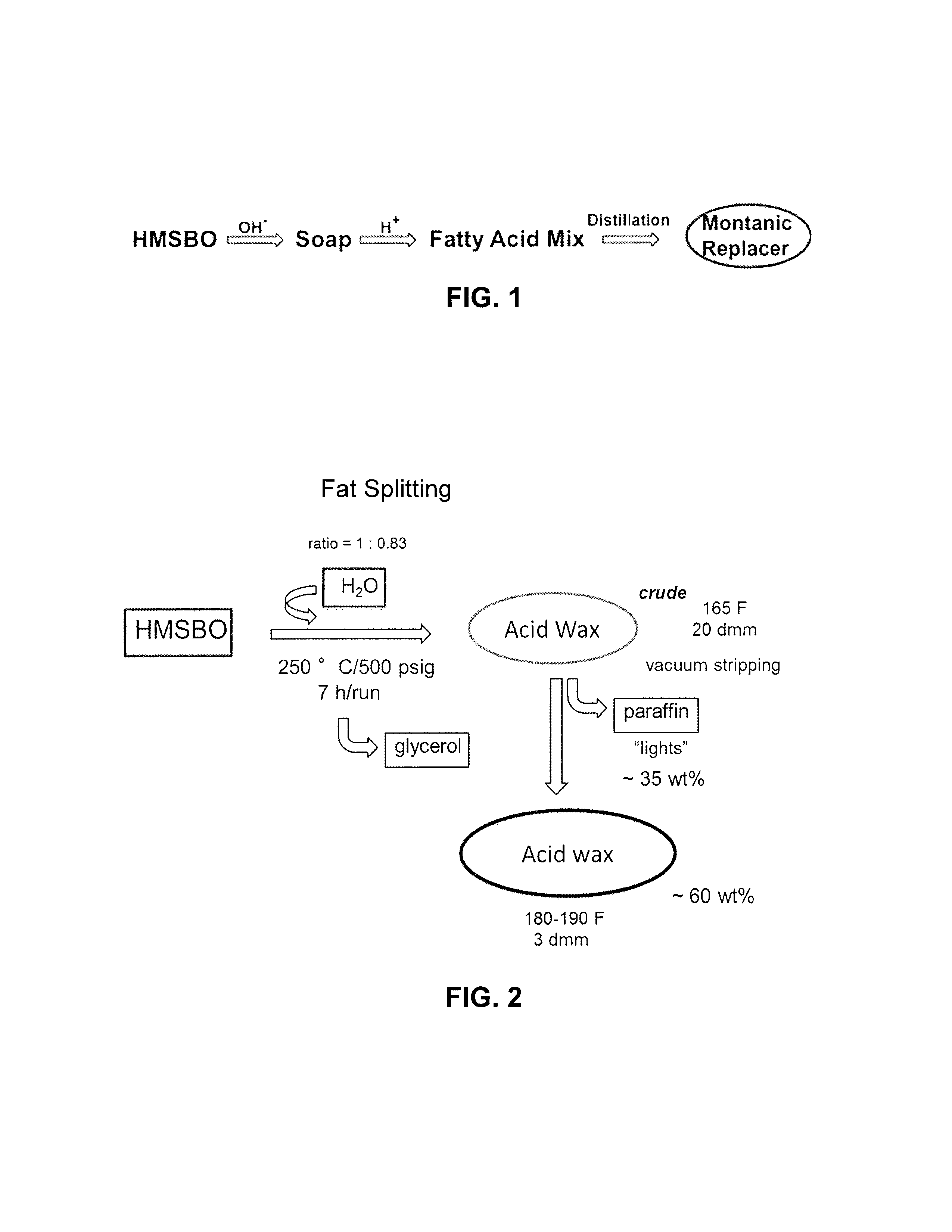Renewable fatty acid waxes and methods of making
a technology of fatty acid waxes and waxes, which is applied in the direction of fatty substance recovery, fatty acid chemical modification, fatty oil/acid recovery from waste, etc., can solve the problems of difficult harvesting of ouricury, extensive and costly cleaning of crude waxes,
- Summary
- Abstract
- Description
- Claims
- Application Information
AI Technical Summary
Benefits of technology
Problems solved by technology
Method used
Image
Examples
example 1
Typical Product Composition
[0081]Five Parr (direct fat splitting runs) were performed on HMSBO to determine the composition of the fatty acid wax product. Calculations were compiled from GC-MS data. Before any stripping or separation was conducted, the “crude” fatty acid wax composition comprised:
[0082]19-26 wt % linear di-acids with terminal carboxylic groups (e.g., HOOC—(CH2)16—COOH) composed of C18, C21, and C24 and higher;
[0083]56-66 wt % linear monoacids with chain lengths according to the acid profile in the oil feedstock, e.g., mainly C16 and C18 for soybean oil, and shorter chain mono-acids due to dimerization and metathesis of unsaturated di-acids with low-molecular-weight olefins during metathesis;
[0084]0-9 wt % triglycerides, diglycerides, monoglycerides, oligomers;
[0085]7-9 wt % paraffin; and
[0086]0-1 wt % free glycerol.
[0087]After a stripping / separation step was performed, the “refined” fatty acid wax composition comprised:
[0088]28-39 wt % linear di-acids with terminal ...
example 2
Exemplary Fat Splitting Reaction
[0098]In one exemplary method of obtaining the fatty acid wax of the present invention, HMSBO was subjected to a fat splitting reaction to obtain a fatty acid wax. In this example, the composition of these fatty acids matches the profile of the starting material, (i.e., the hydrogenated metathesized soybean oil). The product was a high melting point fatty acid wax that may replace montan wax and also was miscible with montan wax. In one example, the composition of the acid wax by fat-splitting is set forth in Table 1, below:
TABLE 1Composition of Wax by Fat-Splitting3.87%Pentadecanoic acid5.94%Hexadecanoic acid28.35%Octadecanoic acid1.71%Eicosanoic acid16.82%Heneicosanoic acid1.39%Docosanoic acid6.98%Tetracosanoic acid34.93%Octadecanedioic acid
example 3
Exemplary Saponification Reaction
[0099]In another method of obtaining the fatty acid wax of the present invention, the HMSBO fatty acid mixture was saponified with an alkali metal hydroxide to obtain a mixture of the salts of fatty acids and free glycerol. Subsequent neutralization of the salts with mineral acids, for example hydrochloric acid, gives the free fatty acids derived from the HMSBO. The composition of these fatty acids matches the profile of the starting material. Additionally, the product after neutralization also may contain metathesis byproducts, such as paraffin (e.g., octadecane) and other lower boiling point components. Because paraffin acts as a plasticizer and drops the melt point of the wax, it is preferred to be removed. The paraffin and other lower boiling point materials were removed from the neutralized mixture by distillation, for example vacuum distillation. In one example, the composition of the acid wax by a saponification method is set forth in Table 2,...
PUM
| Property | Measurement | Unit |
|---|---|---|
| Temperature | aaaaa | aaaaa |
| Temperature | aaaaa | aaaaa |
| Temperature | aaaaa | aaaaa |
Abstract
Description
Claims
Application Information
 Login to View More
Login to View More - R&D
- Intellectual Property
- Life Sciences
- Materials
- Tech Scout
- Unparalleled Data Quality
- Higher Quality Content
- 60% Fewer Hallucinations
Browse by: Latest US Patents, China's latest patents, Technical Efficacy Thesaurus, Application Domain, Technology Topic, Popular Technical Reports.
© 2025 PatSnap. All rights reserved.Legal|Privacy policy|Modern Slavery Act Transparency Statement|Sitemap|About US| Contact US: help@patsnap.com

